- 1LangChain的Memory的4种用法(一)_langchain + memory
- 2独家 | 从零开始用python搭建推荐引擎(附代码)
- 3[LangChain核心模块]模型的输入和输出->Prompts_langchain怎么选择prompt
- 4这7本书Web安全的必须看(附全套PDF)_web安全攻防渗透测试实战指南 pdf
- 5Android系统中Thread,Looper,MessageQueue,Message,Handler相互关系的简单分析_android server new thread looper handlemessage
- 6Linux的虚拟环境下安装GPU版本的torch、torchaudio、torchvision详细过程_linux安装torch
- 7几个数据采集工具分享,都是免费的
- 8Unity 踩坑笔记 两种Animation Clip_unity 给animator里的添加animationclip
- 9蓝屏代码大全(留着自己看)
- 10api-ms-win-core-file-l1-1-0.dll文件找不到的完美解决方法_api-ms-win-core-l1-1-0.dll 丢失
Linux淘金记(二):list_head——链表?会它就够了_list_first_entry_or_null
赞
踩
Linux淘金记(二):list_head——链表?会它就够了
- 一、还在像以前一样写链表吗?
- 二、list_head解千愁
- 三、container_of——通用链表的核中核
- 三、通用算法
- 1. 构造&初始化链表
- 2. list_add 头插节点
- 3. list_add_tail 尾插节点
- 4. list_del&list_del_init 删除节点
- 5. list_replace&list_replace_init 替换节点
- 6. list_move 移动至头部
- 7. list_move_tail 移动至尾部
- 8. list_is_last 表尾?
- 9. list_empty&list_empty_careful 空有表头?
- 10. list_rotate_left 向左旋转
- 11. list_is_singular 只有一个节点?
- 12. list_cut_position&list_cut_before 剪切并粘贴
- 13. list_splice&list_splice_init 头插链表
- 14. list_splice_tail&list_splice_tail_init 尾插链表
- 15. 访问节点结构体
- 16. 遍历链表
- list_for_each&list_for_each_safe 遍历list_head
- list_for_each_prev&list_for_each_prev_safe 向前遍历list_head
- list_for_each_entry&list_for_each_entry_safe 从第一节点向后遍历节点结构体
- list_for_each_entry_reverse&list_for_each_entry_safe_reverse 从表尾向前遍历节点结构体
- list_for_each_entry_continue&list_for_each_entry_safe_continue 从任意节点的下一个节点向后遍历
- list_for_each_entry_continue_reverse 从任意节点的上一个节点向前遍历
- list_for_each_entry_from&list_for_each_entry_safe_from 任意节点开始向后遍历
- list_for_each_entry_from_reverse 任意节点开始向前遍历
- 四、keil上实现list.h
- 五、STM32小试牛刀
- 六、无脑享受吧
每个人的灵魂都是互联的,爱与恨将他们联系在一起。 ——奥斯卡.王尔德
一、还在像以前一样写链表吗?
问题1:把struct info变成双向链表。
struct info {
char *name;
int num;
};
- 1
- 2
- 3
- 4
So easy:
struct info {
struct info *prev;
struct info *next;
char *name;
int num;
};
- 1
- 2
- 3
- 4
- 5
- 6
问题2:写一个函数遍历struct info的环形链表。
也不难:
void list_for_each_info(struct info *head)
{
struct info *iter;
for(iter = head; iter->next != head; iter = iter->next) {
printf("Name: %s Num: %d\r\n", iter->name, iter->num);
}
}
- 1
- 2
- 3
- 4
- 5
- 6
- 7
问题3:把struct another_info变成双向链表,并实现环形链表遍历函数。
struct another_info {
char *version;
char *description;
};
- 1
- 2
- 3
- 4
答:
struct another_info {
struct another_info *prev;
struct another_info *next;
char *version;
char *description;
};
void list_for_each_another_info(struct another_info *head)
{
struct another_info *iter;
for(iter = head; iter->next != head; iter = iter->next) {
printf("Version: %s Description: %s\r\n", iter->version, iter->description);
}
}
- 1
- 2
- 3
- 4
- 5
- 6
- 7
- 8
- 9
- 10
- 11
- 12
- 13
- 14
写到这里是不是觉得做了许多重复的工作,又好像没重复?问题3和问题1、2最大的区别是链表节点结构体由struct info替换为struct another_info,其他算法流程基本上是一模一样。链表的主要算法就是节点结构体的增、删、改、查、遍历,就因为结构体的变化导致我们不得不为每个节点数据结构重新实现上述算法。重复的工作,重复的代码,程序被这些水分充斥着,简直就像个傻子一样。
有没有一个通用的list.h文件,所有链表都可以直接调用里面的API,直接实现增、删、改、查、遍历?
答案是Linux内核的作者们可不是吹出来的。
二、list_head解千愁
每个双向链表都必有struct xxx *next, prev。根据面向对象的思想,为什么不把这两个成员做成一个基类,这样所有节点的结构体都继承自这一父类。Linux的include/linux/list.h就是这么做的:
struct list_head {
struct list_head *prev, *next;
};
- 1
- 2
- 3
这样任何一个结构体挂一个list_head成员就能变成链表节点:
struct info {
char *name;
int num;
struct list_head entry;
};
struct another_info {
struct list_head entry;
char *version;
char *description;
};
- 1
- 2
- 3
- 4
- 5
- 6
- 7
- 8
- 9
- 10
- 11
写算法时也不用千奇百怪的参数类型了,统一使用struct list_head:
void list_for_each(struct list_head *head);
- 1
那么问题来了struct list_head只有prev和next成员,无法访问子类节点结构体的成员。别急,既然人家敢这么写,必然有办法。
三、container_of——通用链表的核中核
这个宏位于include/linux/kernel.h:
/**
* container_of - cast a member of a structure out to the containing structure
* @ptr: the pointer to the member.
* @type: the type of the container struct this is embedded in.
* @member: the name of the member within the struct.
*
*/
#define container_of(ptr, type, member) ({ \
void *__mptr = (void *)(ptr); \
BUILD_BUG_ON_MSG(!__same_type(*(ptr), ((type *)0)->member) && \
!__same_type(*(ptr), void), \
"pointer type mismatch in container_of()"); \
((type *)(__mptr - offsetof(type, member))); })
- 1
- 2
- 3
- 4
- 5
- 6
- 7
- 8
- 9
- 10
- 11
- 12
- 13
利用结构体的内存连续性,通过结构体type的member成员变量的地址ptr来访问结构体type的对象。说人话就是想通过list_head变量找到子类的节点结构体变量就要:
节点结构体变量 = container_of(list_head的地址, 节点结构体的类型, list_head在节点结构体中叫啥)
例如showInfoName通过参数struct list_head *list访问struct info节点:
struct info {
char *name;
int num;
struct list_head entry;
};
void showInfoName(struct list_head *list)
{
struct info *node = container_of(list, struct info, entry);
printf("Name: %s\r\n", node->name);
}
- 1
- 2
- 3
- 4
- 5
- 6
- 7
- 8
- 9
- 10
- 11
原理差不多这样:

原理详见其他大神的文章:
https://blog.csdn.net/wzc18743083828/article/details/118730678
container_of还可以有一种简化的写法:
#define container_of(ptr, type, member) ((type*)(((int)ptr) - (int)(&(((type*)0)->member))))
- 1
三、通用算法
有了通用的链表结构,写通用的算法就成为了可能。所有API的入参均围绕着struct list_head, 不需要杂七杂八的结构体了。内核源码include/linux/list.h就实现了这些API。
1. 构造&初始化链表
构造链表节点使用宏LIST_HEAD:
#define LIST_HEAD_INIT(name) { &(name), &(name) }
#define LIST_HEAD(name) \
struct list_head name = LIST_HEAD_INIT(name)
- 1
- 2
- 3
- 4
节点初始化函数INIT_LIST_HEAD:
static inline void INIT_LIST_HEAD(struct list_head *list)
{
WRITE_ONCE(list->next, list);
list->prev = list;
}
- 1
- 2
- 3
- 4
- 5
构造或初始化链表节点后,该节点的next和prev指向自己。
2. list_add 头插节点
把一个节点插入到表头后面:
/* * Insert a new entry between two known consecutive entries. * * This is only for internal list manipulation where we know * the prev/next entries already! */ static inline void __list_add(struct list_head *new, struct list_head *prev, struct list_head *next) { if (!__list_add_valid(new, prev, next)) return; next->prev = new; new->next = next; new->prev = prev; WRITE_ONCE(prev->next, new); } /** * list_add - add a new entry * @new: new entry to be added * @head: list head to add it after * * Insert a new entry after the specified head. * This is good for implementing stacks. */ static inline void list_add(struct list_head *new, struct list_head *head) { __list_add(new, head, head->next); }
- 1
- 2
- 3
- 4
- 5
- 6
- 7
- 8
- 9
- 10
- 11
- 12
- 13
- 14
- 15
- 16
- 17
- 18
- 19
- 20
- 21
- 22
- 23
- 24
- 25
- 26
- 27
- 28
- 29
- 30
- 31
示例:list_add(entry3, head);
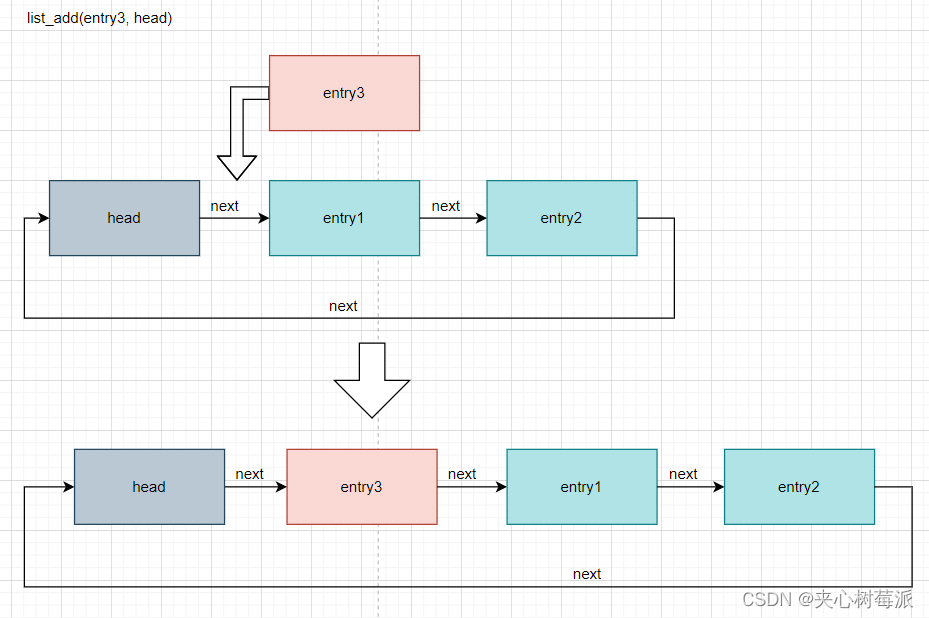
3. list_add_tail 尾插节点
把一个节点插入到链表尾部:
/**
* list_add_tail - add a new entry
* @new: new entry to be added
* @head: list head to add it before
*
* Insert a new entry before the specified head.
* This is useful for implementing queues.
*/
static inline void list_add_tail(struct list_head *new, struct list_head *head)
{
__list_add(new, head->prev, head);
}
- 1
- 2
- 3
- 4
- 5
- 6
- 7
- 8
- 9
- 10
- 11
- 12
示例:list_add_tail(entry3, head);
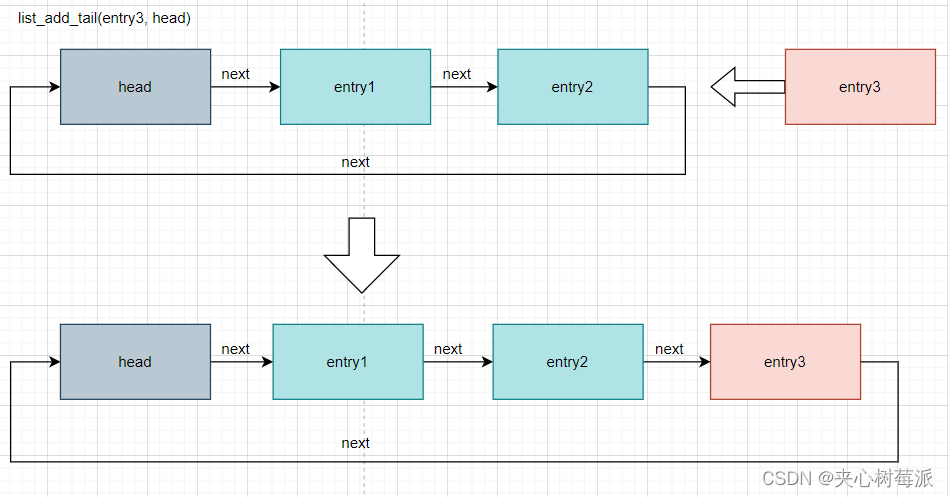
4. list_del&list_del_init 删除节点
删除一个节点:
/* * Delete a list entry by making the prev/next entries * point to each other. * * This is only for internal list manipulation where we know * the prev/next entries already! */ static inline void __list_del(struct list_head * prev, struct list_head * next) { next->prev = prev; WRITE_ONCE(prev->next, next); } /** * list_del - deletes entry from list. * @entry: the element to delete from the list. * Note: list_empty() on entry does not return true after this, the entry is * in an undefined state. */ static inline void __list_del_entry(struct list_head *entry) { if (!__list_del_entry_valid(entry)) return; __list_del(entry->prev, entry->next); } static inline void list_del(struct list_head *entry) { __list_del_entry(entry); entry->next = LIST_POISON1; entry->prev = LIST_POISON2; }
- 1
- 2
- 3
- 4
- 5
- 6
- 7
- 8
- 9
- 10
- 11
- 12
- 13
- 14
- 15
- 16
- 17
- 18
- 19
- 20
- 21
- 22
- 23
- 24
- 25
- 26
- 27
- 28
- 29
- 30
- 31
- 32
- 33
示例:list_del(entry1);
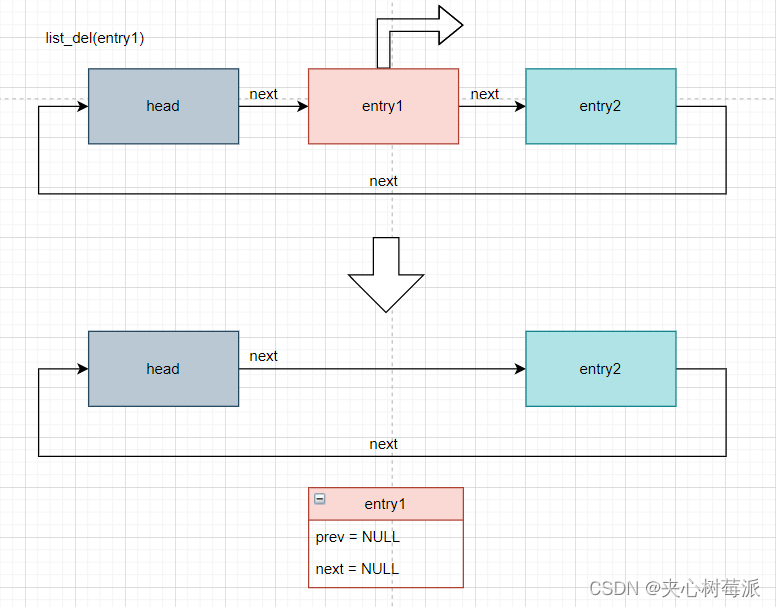
list_del_init,把删除掉的节点重新初始化:
/**
* list_del_init - deletes entry from list and reinitialize it.
* @entry: the element to delete from the list.
*/
static inline void list_del_init(struct list_head *entry)
{
__list_del_entry(entry);
INIT_LIST_HEAD(entry);
}
- 1
- 2
- 3
- 4
- 5
- 6
- 7
- 8
- 9
示例:list_del_init(entry1);
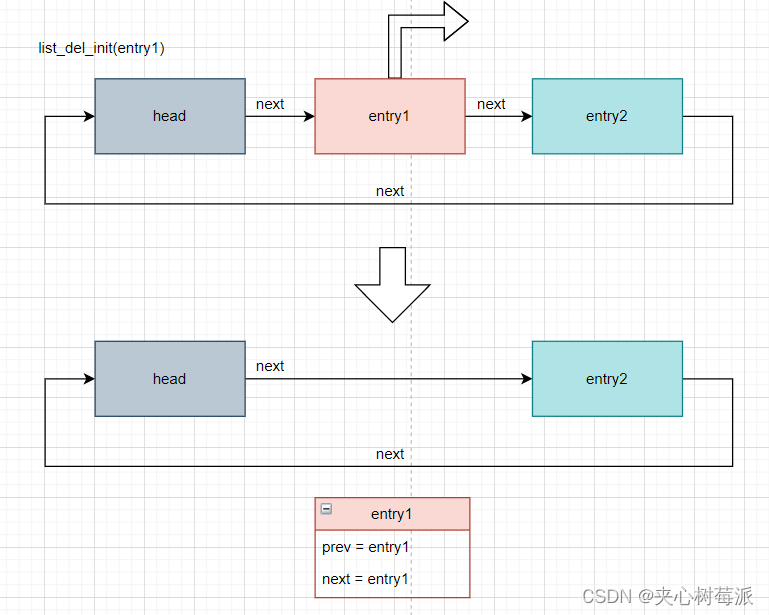
5. list_replace&list_replace_init 替换节点
list_replace把链表中的一个节点替换为另一个节点:
/** * list_replace - replace old entry by new one * @old : the element to be replaced * @new : the new element to insert * * If @old was empty, it will be overwritten. */ static inline void list_replace(struct list_head *old, struct list_head *new) { new->next = old->next; new->next->prev = new; new->prev = old->prev; new->prev->next = new; } static inline void list_replace_init(struct list_head *old, struct list_head *new) { list_replace(old, new); INIT_LIST_HEAD(old); }
- 1
- 2
- 3
- 4
- 5
- 6
- 7
- 8
- 9
- 10
- 11
- 12
- 13
- 14
- 15
- 16
- 17
- 18
- 19
- 20
- 21
- 22
示例:list_replace(entry1, new);
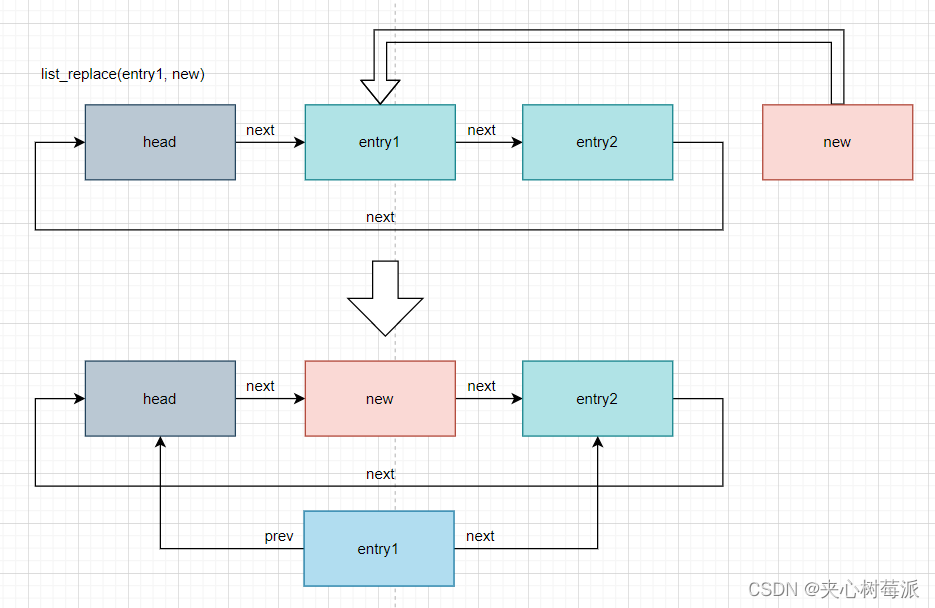
list_replace_init替换节点后,把被替换下来的节点重新初始化,示例:list_replace_init(entry1, new);
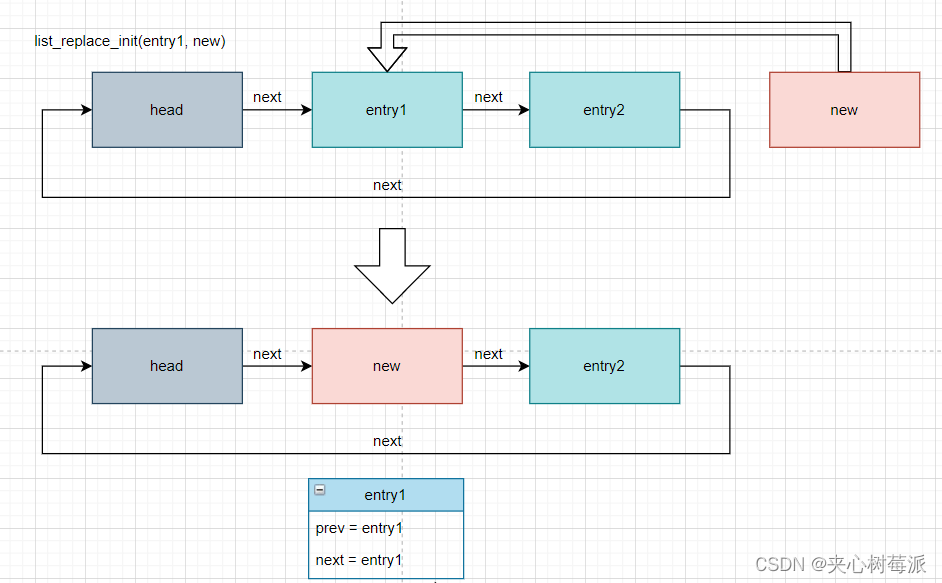
6. list_move 移动至头部
把链表的一个节点移动到另一个链表表头后面:
/**
* list_move - delete from one list and add as another's head
* @list: the entry to move
* @head: the head that will precede our entry
*/
static inline void list_move(struct list_head *list, struct list_head *head)
{
__list_del_entry(list);
list_add(list, head);
}
- 1
- 2
- 3
- 4
- 5
- 6
- 7
- 8
- 9
- 10
示例:list_move(entry1, head2);
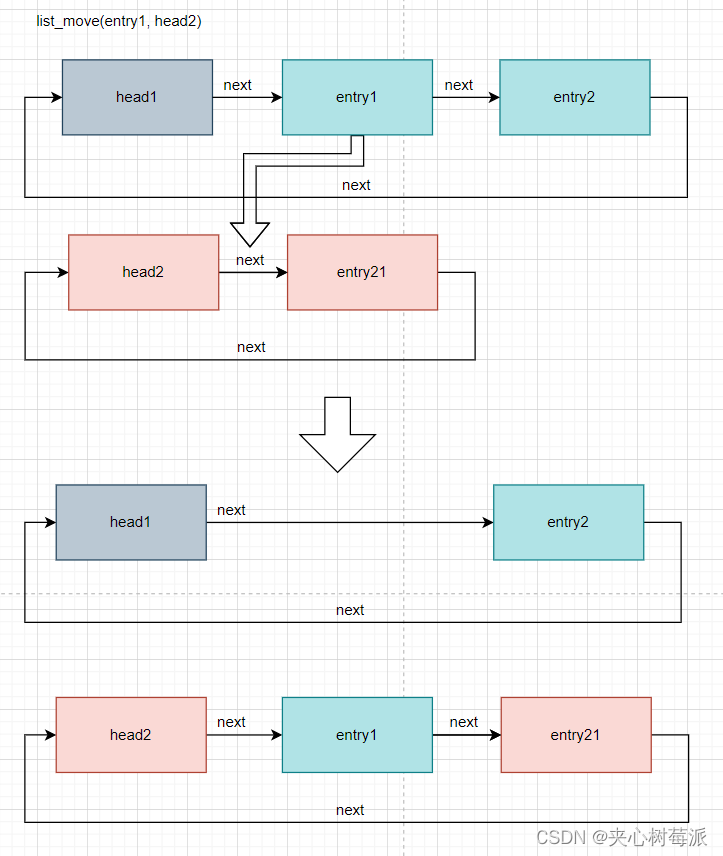
7. list_move_tail 移动至尾部
把链表的一个节点移动到另一个链表尾部:
/**
* list_move_tail - delete from one list and add as another's tail
* @list: the entry to move
* @head: the head that will follow our entry
*/
static inline void list_move_tail(struct list_head *list,
struct list_head *head)
{
__list_del_entry(list);
list_add_tail(list, head);
}
- 1
- 2
- 3
- 4
- 5
- 6
- 7
- 8
- 9
- 10
- 11
示例:list_move_tail(entry1, head2);

8. list_is_last 表尾?
list_is_last判断节点是否为表尾,是的返回1,否返回0:
/**
* list_is_last - tests whether @list is the last entry in list @head
* @list: the entry to test
* @head: the head of the list
*/
static inline int list_is_last(const struct list_head *list,
const struct list_head *head)
{
return list->next == head;
}
- 1
- 2
- 3
- 4
- 5
- 6
- 7
- 8
- 9
- 10
9. list_empty&list_empty_careful 空有表头?
list_empty判断链表是否空(仅有表头,未挂有任何节点),是的返回1,否返回0,list_empty_careful 为多核的安全版本:
/** * list_empty - tests whether a list is empty * @head: the list to test. */ static inline int list_empty(const struct list_head *head) { return READ_ONCE(head->next) == head; } /** * list_empty_careful - tests whether a list is empty and not being modified * @head: the list to test * * Description: * tests whether a list is empty _and_ checks that no other CPU might be * in the process of modifying either member (next or prev) * * NOTE: using list_empty_careful() without synchronization * can only be safe if the only activity that can happen * to the list entry is list_del_init(). Eg. it cannot be used * if another CPU could re-list_add() it. */ static inline int list_empty_careful(const struct list_head *head) { struct list_head *next = head->next; return (next == head) && (next == head->prev); }
- 1
- 2
- 3
- 4
- 5
- 6
- 7
- 8
- 9
- 10
- 11
- 12
- 13
- 14
- 15
- 16
- 17
- 18
- 19
- 20
- 21
- 22
- 23
- 24
- 25
- 26
- 27
10. list_rotate_left 向左旋转
表头不动,所有节点全部向表头方向移动一格,表头后第一个节点被旋转至表尾:
/**
* list_rotate_left - rotate the list to the left
* @head: the head of the list
*/
static inline void list_rotate_left(struct list_head *head)
{
struct list_head *first;
if (!list_empty(head)) {
first = head->next;
list_move_tail(first, head);
}
}
- 1
- 2
- 3
- 4
- 5
- 6
- 7
- 8
- 9
- 10
- 11
- 12
- 13
示例:list_rotate_left(head);
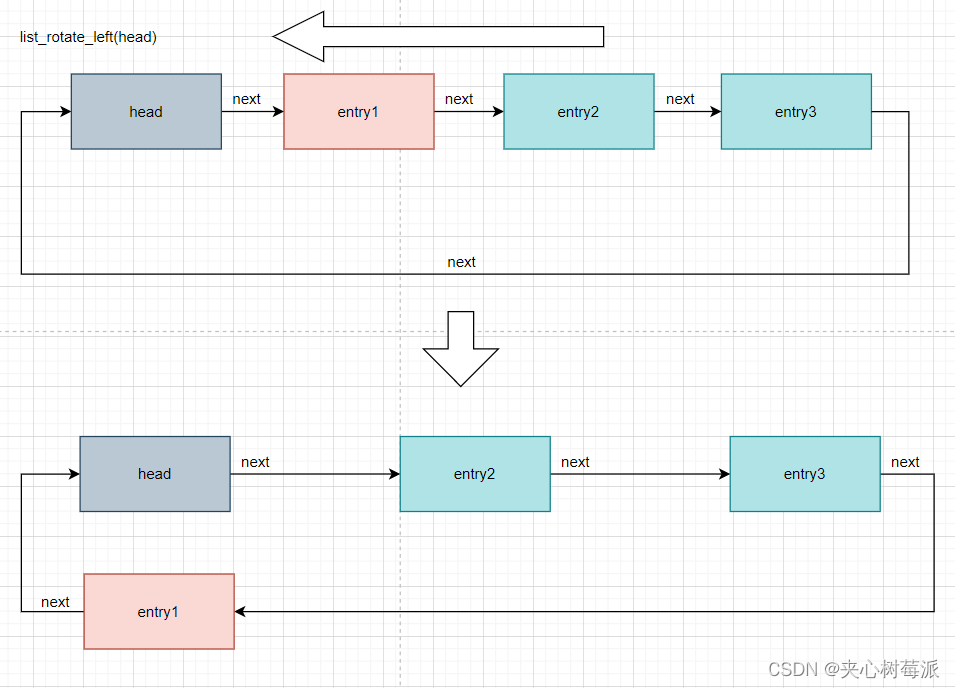
11. list_is_singular 只有一个节点?
判断表头非空且是否只挂了一个节点,是返回1,否返回0:
/**
* list_is_singular - tests whether a list has just one entry.
* @head: the list to test.
*/
static inline int list_is_singular(const struct list_head *head)
{
return !list_empty(head) && (head->next == head->prev);
}
- 1
- 2
- 3
- 4
- 5
- 6
- 7
- 8
12. list_cut_position&list_cut_before 剪切并粘贴
static inline void __list_cut_position(struct list_head *list, struct list_head *head, struct list_head *entry) { struct list_head *new_first = entry->next; list->next = head->next; list->next->prev = list; list->prev = entry; entry->next = list; head->next = new_first; new_first->prev = head; } /** * list_cut_position - cut a list into two * @list: a new list to add all removed entries * @head: a list with entries * @entry: an entry within head, could be the head itself * and if so we won't cut the list * * This helper moves the initial part of @head, up to and * including @entry, from @head to @list. You should * pass on @entry an element you know is on @head. @list * should be an empty list or a list you do not care about * losing its data. * */ static inline void list_cut_position(struct list_head *list, struct list_head *head, struct list_head *entry) { if (list_empty(head)) return; if (list_is_singular(head) && (head->next != entry && head != entry)) return; if (entry == head) INIT_LIST_HEAD(list); else __list_cut_position(list, head, entry); } /** * list_cut_before - cut a list into two, before given entry * @list: a new list to add all removed entries * @head: a list with entries * @entry: an entry within head, could be the head itself * * This helper moves the initial part of @head, up to but * excluding @entry, from @head to @list. You should pass * in @entry an element you know is on @head. @list should * be an empty list or a list you do not care about losing * its data. * If @entry == @head, all entries on @head are moved to * @list. */ static inline void list_cut_before(struct list_head *list, struct list_head *head, struct list_head *entry) { if (head->next == entry) { INIT_LIST_HEAD(list); return; } list->next = head->next; list->next->prev = list; list->prev = entry->prev; list->prev->next = list; head->next = entry; entry->prev = head; }
- 1
- 2
- 3
- 4
- 5
- 6
- 7
- 8
- 9
- 10
- 11
- 12
- 13
- 14
- 15
- 16
- 17
- 18
- 19
- 20
- 21
- 22
- 23
- 24
- 25
- 26
- 27
- 28
- 29
- 30
- 31
- 32
- 33
- 34
- 35
- 36
- 37
- 38
- 39
- 40
- 41
- 42
- 43
- 44
- 45
- 46
- 47
- 48
- 49
- 50
- 51
- 52
- 53
- 54
- 55
- 56
- 57
- 58
- 59
- 60
- 61
- 62
- 63
- 64
- 65
- 66
- 67
- 68
- 69
list_cut_position(struct list_head *list, struct list_head *head, struct list_head *entry)在链表head上剪切掉表头后第一个节点一直到entry节点,再把它们插入到list表头后面。
示例:list_cut_position(head2, head1, entry2) ;
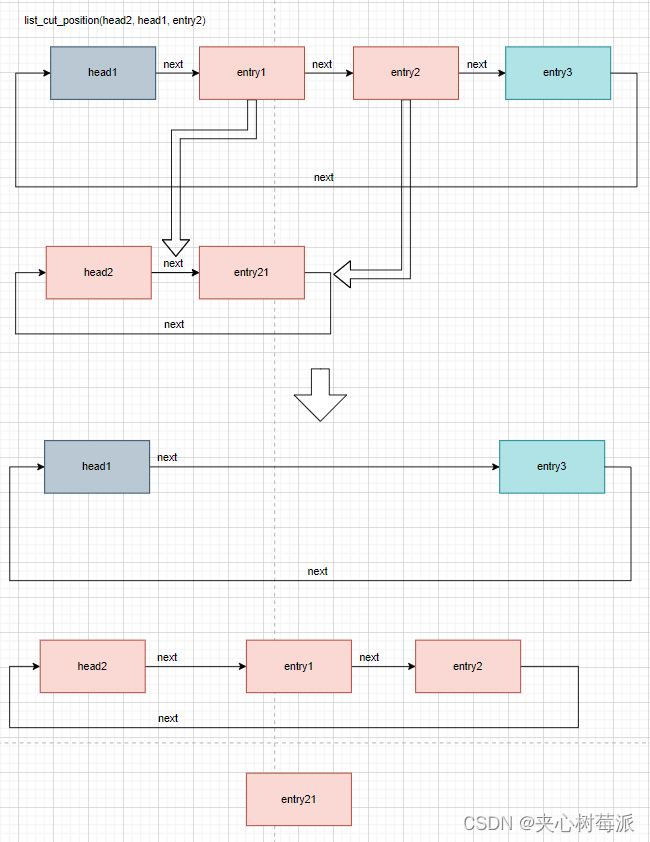
list_cut_before(struct list_head *list, struct list_head *head, struct list_head *entry)与list_cut_position的区别在于list_cut_before剪切的链表不包括entry节点。
示例:list_cut_before(head2, head1, entry3) ;
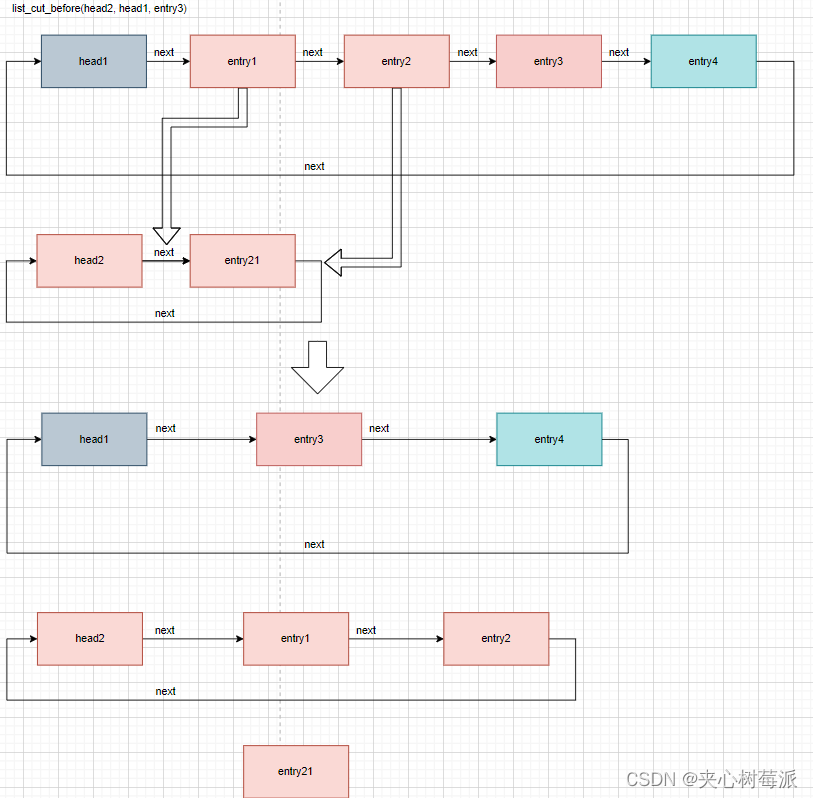
13. list_splice&list_splice_init 头插链表
list_splice(const struct list_head *list, struct list_head *head) 把list后面挂载的所有节点都移动并插入到head的表头后:
static inline void __list_splice(const struct list_head *list, struct list_head *prev, struct list_head *next) { struct list_head *first = list->next; struct list_head *last = list->prev; first->prev = prev; prev->next = first; last->next = next; next->prev = last; } /** * list_splice - join two lists, this is designed for stacks * @list: the new list to add. * @head: the place to add it in the first list. */ static inline void list_splice(const struct list_head *list, struct list_head *head) { if (!list_empty(list)) __list_splice(list, head, head->next); }
- 1
- 2
- 3
- 4
- 5
- 6
- 7
- 8
- 9
- 10
- 11
- 12
- 13
- 14
- 15
- 16
- 17
- 18
- 19
- 20
- 21
- 22
- 23
- 24
- 25
示例:list_splice(head2, head1);
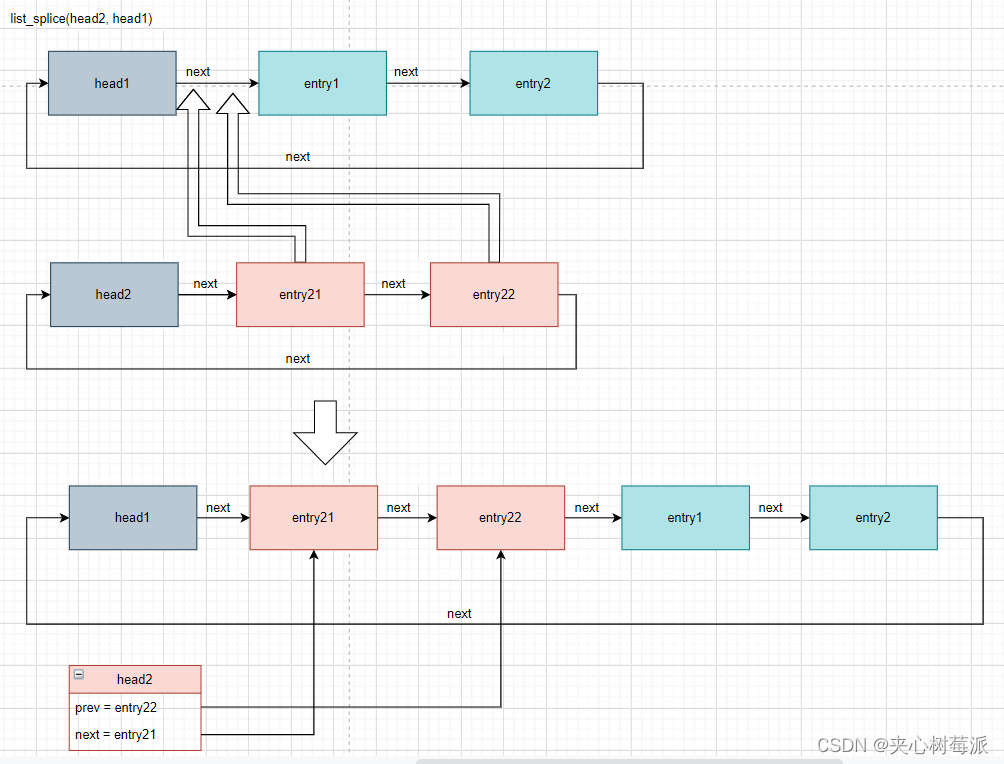
list_splice_init(struct list_head *list, struct list_head *head) 完成移动后,把表头list再初始化一遍:
/**
* list_splice_init - join two lists and reinitialise the emptied list.
* @list: the new list to add.
* @head: the place to add it in the first list.
*
* The list at @list is reinitialised
*/
static inline void list_splice_init(struct list_head *list,
struct list_head *head)
{
if (!list_empty(list)) {
__list_splice(list, head, head->next);
INIT_LIST_HEAD(list);
}
}
- 1
- 2
- 3
- 4
- 5
- 6
- 7
- 8
- 9
- 10
- 11
- 12
- 13
- 14
- 15
示例:list_splice_init(head2, head1);
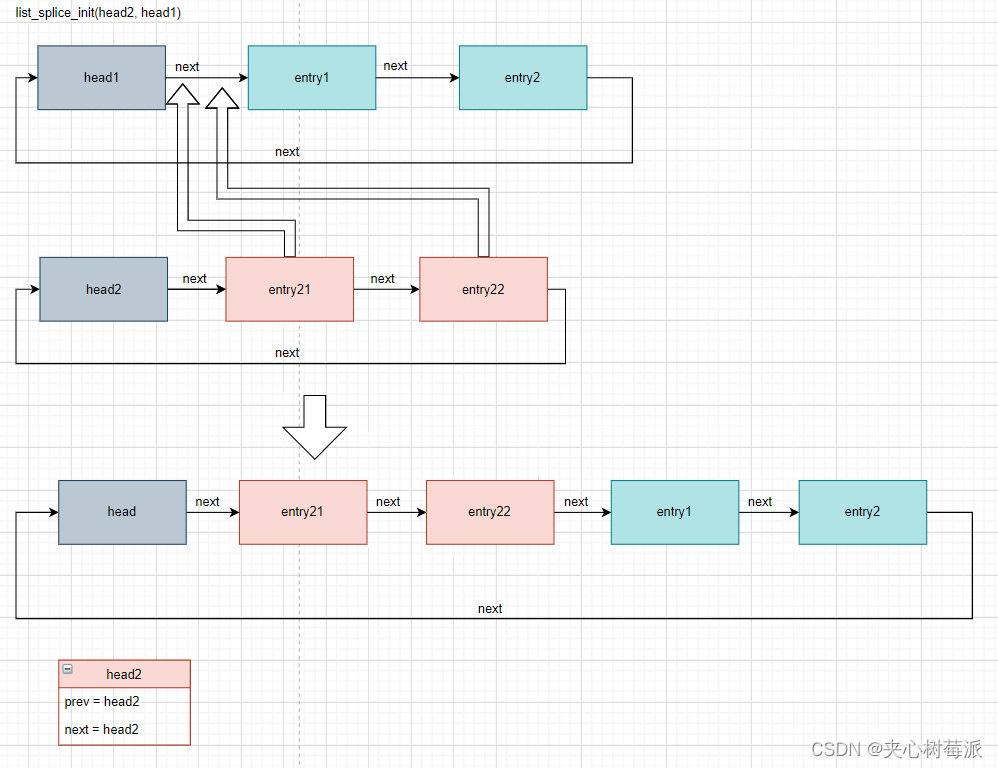
14. list_splice_tail&list_splice_tail_init 尾插链表
与list_splice&list_splice_init类似,不过这个把链表插入到表尾。
list_splice_tail:
/**
* list_splice_tail - join two lists, each list being a queue
* @list: the new list to add.
* @head: the place to add it in the first list.
*/
static inline void list_splice_tail(struct list_head *list,
struct list_head *head)
{
if (!list_empty(list))
__list_splice(list, head->prev, head);
}
- 1
- 2
- 3
- 4
- 5
- 6
- 7
- 8
- 9
- 10
- 11
示例:list_splice_tail(head2, head1);

list_splice_tail_init:
/** * list_splice_tail_init - join two lists and reinitialise the emptied list * @list: the new list to add. * @head: the place to add it in the first list. * * Each of the lists is a queue. * The list at @list is reinitialised */ static inline void list_splice_tail_init(struct list_head *list, struct list_head *head) { if (!list_empty(list)) { __list_splice(list, head->prev, head); INIT_LIST_HEAD(list); } }
- 1
- 2
- 3
- 4
- 5
- 6
- 7
- 8
- 9
- 10
- 11
- 12
- 13
- 14
- 15
- 16
示例:list_splice_tail_init(head2, head1);
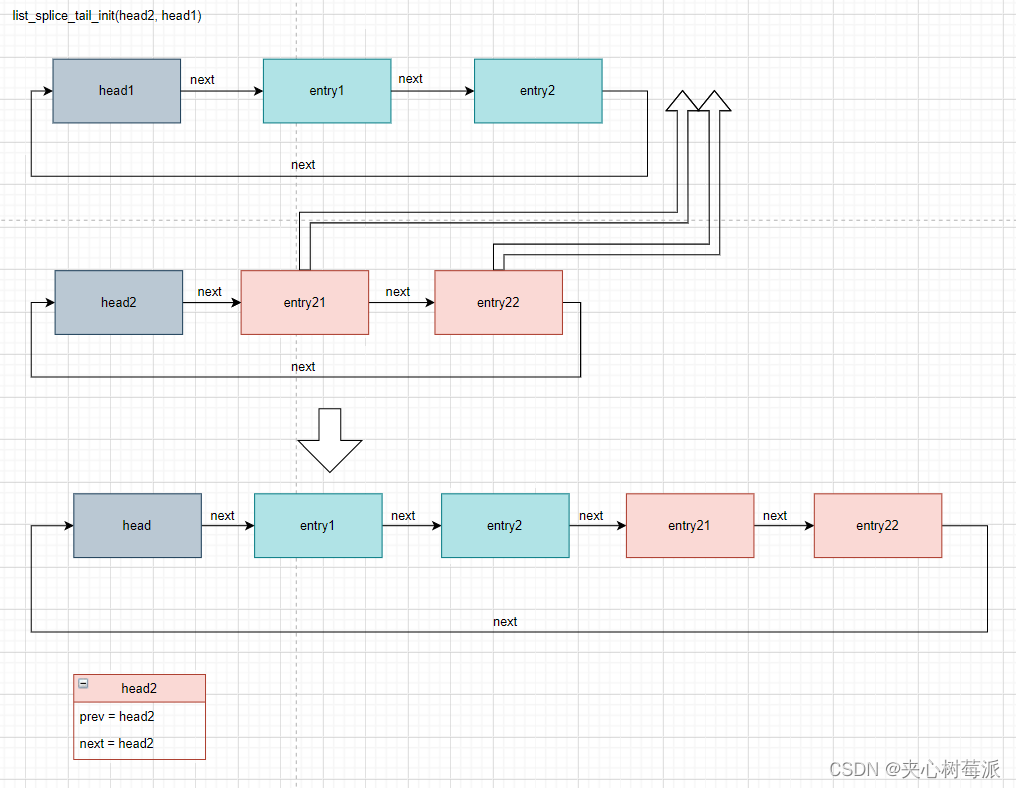
15. 访问节点结构体
list_entry 访问本节点结构体
/**
* list_entry - get the struct for this entry
* @ptr: the &struct list_head pointer.
* @type: the type of the struct this is embedded in.
* @member: the name of the list_head within the struct.
*/
#define list_entry(ptr, type, member) \
container_of(ptr, type, member)
- 1
- 2
- 3
- 4
- 5
- 6
- 7
- 8
其实就是container_of换个说法。
list_first_entry 访问第一个节点结构体
/**
* list_first_entry - get the first element from a list
* @ptr: the list head to take the element from.
* @type: the type of the struct this is embedded in.
* @member: the name of the list_head within the struct.
*
* Note, that list is expected to be not empty.
*/
#define list_first_entry(ptr, type, member) \
list_entry((ptr)->next, type, member)
- 1
- 2
- 3
- 4
- 5
- 6
- 7
- 8
- 9
- 10
访问表头后第一个结构体,因此使用前需检查链表不能为空。
list_last_entry 访问表尾结构体
/**
* list_last_entry - get the last element from a list
* @ptr: the list head to take the element from.
* @type: the type of the struct this is embedded in.
* @member: the name of the list_head within the struct.
*
* Note, that list is expected to be not empty.
*/
#define list_last_entry(ptr, type, member) \
list_entry((ptr)->prev, type, member)
- 1
- 2
- 3
- 4
- 5
- 6
- 7
- 8
- 9
- 10
list_first_entry_or_null 访问第一个节点结构体否则返回空
/**
* list_first_entry_or_null - get the first element from a list
* @ptr: the list head to take the element from.
* @type: the type of the struct this is embedded in.
* @member: the name of the list_head within the struct.
*
* Note that if the list is empty, it returns NULL.
*/
#define list_first_entry_or_null(ptr, type, member) ({ \
struct list_head *head__ = (ptr); \
struct list_head *pos__ = READ_ONCE(head__->next); \
pos__ != head__ ? list_entry(pos__, type, member) : NULL; \
})
- 1
- 2
- 3
- 4
- 5
- 6
- 7
- 8
- 9
- 10
- 11
- 12
- 13
如果链表为空,返回NULL。
list_next_entry 访问下一个节点结构体
/**
* list_next_entry - get the next element in list
* @pos: the type * to cursor
* @member: the name of the list_head within the struct.
*/
#define list_next_entry(pos, member) \
list_entry((pos)->member.next, typeof(*(pos)), member)
- 1
- 2
- 3
- 4
- 5
- 6
- 7
list_prev_entry 访问上一个节点结构体
/**
* list_prev_entry - get the prev element in list
* @pos: the type * to cursor
* @member: the name of the list_head within the struct.
*/
#define list_prev_entry(pos, member) \
list_entry((pos)->member.prev, typeof(*(pos)), member)
- 1
- 2
- 3
- 4
- 5
- 6
- 7
16. 遍历链表
list_for_each&list_for_each_safe 遍历list_head
迭代器pos为struct list_head:
/**
* list_for_each - iterate over a list
* @pos: the &struct list_head to use as a loop cursor.
* @head: the head for your list.
*/
#define list_for_each(pos, head) \
for (pos = (head)->next; pos != (head); pos = pos->next)
- 1
- 2
- 3
- 4
- 5
- 6
- 7
通过list_head成员向next方向遍历链表,不访问每个节点的结构体。
安全版本:
/**
* list_for_each_safe - iterate over a list safe against removal of list entry
* @pos: the &struct list_head to use as a loop cursor.
* @n: another &struct list_head to use as temporary storage
* @head: the head for your list.
*/
#define list_for_each_safe(pos, n, head) \
for (pos = (head)->next, n = pos->next; pos != (head); \
pos = n, n = pos->next)
- 1
- 2
- 3
- 4
- 5
- 6
- 7
- 8
- 9
list_for_each_prev&list_for_each_prev_safe 向前遍历list_head
迭代器pos为struct list_head:
/**
* list_for_each_prev - iterate over a list backwards
* @pos: the &struct list_head to use as a loop cursor.
* @head: the head for your list.
*/
#define list_for_each_prev(pos, head) \
for (pos = (head)->prev; pos != (head); pos = pos->prev)
- 1
- 2
- 3
- 4
- 5
- 6
- 7
通过list_head成员向prev方向遍历链表,不访问每个节点的结构体。
安全版本:
/**
* list_for_each_prev_safe - iterate over a list backwards safe against removal of list entry
* @pos: the &struct list_head to use as a loop cursor.
* @n: another &struct list_head to use as temporary storage
* @head: the head for your list.
*/
#define list_for_each_prev_safe(pos, n, head) \
for (pos = (head)->prev, n = pos->prev; \
pos != (head); \
pos = n, n = pos->prev)
- 1
- 2
- 3
- 4
- 5
- 6
- 7
- 8
- 9
- 10
list_for_each_entry&list_for_each_entry_safe 从第一节点向后遍历节点结构体
迭代器pos为节点结构体类型typeof(*pos):
/**
* list_for_each_entry - iterate over list of given type
* @pos: the type * to use as a loop cursor.
* @head: the head for your list.
* @member: the name of the list_head within the struct.
*/
#define list_for_each_entry(pos, head, member) \
for (pos = list_first_entry(head, typeof(*pos), member); \
&pos->member != (head); \
pos = list_next_entry(pos, member))
- 1
- 2
- 3
- 4
- 5
- 6
- 7
- 8
- 9
- 10
从表头后的第一个节点向next方向遍历链表,访问每个节点结构体。
安全版本:
/**
* list_for_each_entry_safe - iterate over list of given type safe against removal of list entry
* @pos: the type * to use as a loop cursor.
* @n: another type * to use as temporary storage
* @head: the head for your list.
* @member: the name of the list_head within the struct.
*/
#define list_for_each_entry_safe(pos, n, head, member) \
for (pos = list_first_entry(head, typeof(*pos), member), \
n = list_next_entry(pos, member); \
&pos->member != (head); \
pos = n, n = list_next_entry(n, member))
- 1
- 2
- 3
- 4
- 5
- 6
- 7
- 8
- 9
- 10
- 11
- 12
list_for_each_entry_reverse&list_for_each_entry_safe_reverse 从表尾向前遍历节点结构体
迭代器pos为节点结构体类型typeof(*pos):
/**
* list_for_each_entry_reverse - iterate backwards over list of given type.
* @pos: the type * to use as a loop cursor.
* @head: the head for your list.
* @member: the name of the list_head within the struct.
*/
#define list_for_each_entry_reverse(pos, head, member) \
for (pos = list_last_entry(head, typeof(*pos), member); \
&pos->member != (head); \
pos = list_prev_entry(pos, member))
- 1
- 2
- 3
- 4
- 5
- 6
- 7
- 8
- 9
- 10
从表尾节点向prev方向遍历链表,访问每个节点结构体。
安全版本:
/**
* list_for_each_entry_safe_reverse - iterate backwards over list safe against removal
* @pos: the type * to use as a loop cursor.
* @n: another type * to use as temporary storage
* @head: the head for your list.
* @member: the name of the list_head within the struct.
*
* Iterate backwards over list of given type, safe against removal
* of list entry.
*/
#define list_for_each_entry_safe_reverse(pos, n, head, member) \
for (pos = list_last_entry(head, typeof(*pos), member), \
n = list_prev_entry(pos, member); \
&pos->member != (head); \
pos = n, n = list_prev_entry(n, member))
- 1
- 2
- 3
- 4
- 5
- 6
- 7
- 8
- 9
- 10
- 11
- 12
- 13
- 14
- 15
list_for_each_entry_continue&list_for_each_entry_safe_continue 从任意节点的下一个节点向后遍历
迭代器pos为节点结构体类型typeof(*pos):
/**
* list_for_each_entry_continue - continue iteration over list of given type
* @pos: the type * to use as a loop cursor.
* @head: the head for your list.
* @member: the name of the list_head within the struct.
*
* Continue to iterate over list of given type, continuing after
* the current position.
*/
#define list_for_each_entry_continue(pos, head, member) \
for (pos = list_next_entry(pos, member); \
&pos->member != (head); \
pos = list_next_entry(pos, member))
- 1
- 2
- 3
- 4
- 5
- 6
- 7
- 8
- 9
- 10
- 11
- 12
- 13
从任意节点的下一个节点向next方向遍历,直到表头。
安全版本:
/**
* list_for_each_entry_safe_continue - continue list iteration safe against removal
* @pos: the type * to use as a loop cursor.
* @n: another type * to use as temporary storage
* @head: the head for your list.
* @member: the name of the list_head within the struct.
*
* Iterate over list of given type, continuing after current point,
* safe against removal of list entry.
*/
#define list_for_each_entry_safe_continue(pos, n, head, member) \
for (pos = list_next_entry(pos, member), \
n = list_next_entry(pos, member); \
&pos->member != (head); \
pos = n, n = list_next_entry(n, member))
- 1
- 2
- 3
- 4
- 5
- 6
- 7
- 8
- 9
- 10
- 11
- 12
- 13
- 14
- 15
list_for_each_entry_continue_reverse 从任意节点的上一个节点向前遍历
迭代器pos为节点结构体类型typeof(*pos):
/**
* list_for_each_entry_continue_reverse - iterate backwards from the given point
* @pos: the type * to use as a loop cursor.
* @head: the head for your list.
* @member: the name of the list_head within the struct.
*
* Start to iterate over list of given type backwards, continuing after
* the current position.
*/
#define list_for_each_entry_continue_reverse(pos, head, member) \
for (pos = list_prev_entry(pos, member); \
&pos->member != (head); \
pos = list_prev_entry(pos, member))
- 1
- 2
- 3
- 4
- 5
- 6
- 7
- 8
- 9
- 10
- 11
- 12
- 13
从任意节点的上一个节点向prev方向遍历,直到表头。
list_for_each_entry_from&list_for_each_entry_safe_from 任意节点开始向后遍历
迭代器pos为节点结构体类型typeof(*pos):
/**
* list_for_each_entry_from - iterate over list of given type from the current point
* @pos: the type * to use as a loop cursor.
* @head: the head for your list.
* @member: the name of the list_head within the struct.
*
* Iterate over list of given type, continuing from current position.
*/
#define list_for_each_entry_from(pos, head, member) \
for (; &pos->member != (head); \
pos = list_next_entry(pos, member))
- 1
- 2
- 3
- 4
- 5
- 6
- 7
- 8
- 9
- 10
- 11
从任意节点开始(包括该节点)向next方向遍历,直到表头。
安全版本:
/**
* list_for_each_entry_safe_from - iterate over list from current point safe against removal
* @pos: the type * to use as a loop cursor.
* @n: another type * to use as temporary storage
* @head: the head for your list.
* @member: the name of the list_head within the struct.
*
* Iterate over list of given type from current point, safe against
* removal of list entry.
*/
#define list_for_each_entry_safe_from(pos, n, head, member) \
for (n = list_next_entry(pos, member); \
&pos->member != (head); \
pos = n, n = list_next_entry(n, member))
- 1
- 2
- 3
- 4
- 5
- 6
- 7
- 8
- 9
- 10
- 11
- 12
- 13
- 14
list_for_each_entry_from_reverse 任意节点开始向前遍历
迭代器pos为节点结构体类型typeof(*pos):
/**
* list_for_each_entry_from_reverse - iterate backwards over list of given type
* from the current point
* @pos: the type * to use as a loop cursor.
* @head: the head for your list.
* @member: the name of the list_head within the struct.
*
* Iterate backwards over list of given type, continuing from current position.
*/
#define list_for_each_entry_from_reverse(pos, head, member) \
for (; &pos->member != (head); \
pos = list_prev_entry(pos, member))
- 1
- 2
- 3
- 4
- 5
- 6
- 7
- 8
- 9
- 10
- 11
- 12
从任意节点开始(包括该节点)向prev方向遍历,直到表头。
四、keil上实现list.h
基本上直接CtrlCV,简化了一些宏,container_of的实现源码是在kernel.h中,这里直接在list.h里实现:
#ifndef container_of
#define container_of(ptr, type, member) ((type*)(((int)ptr) - (int)(&(((type*)0)->member))))
#endif
- 1
- 2
- 3
由于没有#include其他头文件,可以认为是平台无关的代码。需要注意的是typeof这个宏属于gnu的语法,keil的armcc编译器需要如下配置以支持gnu语法:

keil的lst.h如下:
#ifndef __LIST_H #define __LIST_H struct list_head { struct list_head *prev, *next; }; #ifndef NULL #define NULL 0 #endif #ifndef container_of #define container_of(ptr, type, member) ((type*)(((int)ptr) - (int)(&(((type*)0)->member)))) #endif /* * Simple doubly linked list implementation. * * Some of the internal functions ("__xxx") are useful when * manipulating whole lists rather than single entries, as * sometimes we already know the next/prev entries and we can * generate better code by using them directly rather than * using the generic single-entry routines. */ #define LIST_HEAD_INIT(name) { &(name), &(name) } #define LIST_HEAD(name) \ struct list_head name = LIST_HEAD_INIT(name) static inline void INIT_LIST_HEAD(struct list_head *list) { list->next = list; list->prev = list; } /* * Insert a new entry between two known consecutive entries. * * This is only for internal list manipulation where we know * the prev/next entries already! */ static inline void __list_add(struct list_head *new, struct list_head *prev, struct list_head *next) { next->prev = new; new->next = next; new->prev = prev; prev->next = new; } /** * list_add - add a new entry * @new: new entry to be added * @head: list head to add it after * * Insert a new entry after the specified head. * This is good for implementing stacks. */ static inline void list_add(struct list_head *new, struct list_head *head) { __list_add(new, head, head->next); } /** * list_add_tail - add a new entry * @new: new entry to be added * @head: list head to add it before * * Insert a new entry before the specified head. * This is useful for implementing queues. */ static inline void list_add_tail(struct list_head *new, struct list_head *head) { __list_add(new, head->prev, head); } /* * Delete a list entry by making the prev/next entries * point to each other. * * This is only for internal list manipulation where we know * the prev/next entries already! */ static inline void __list_del(struct list_head * prev, struct list_head * next) { next->prev = prev; prev->next = next; } /** * list_del - deletes entry from list. * @entry: the element to delete from the list. * Note: list_empty() on entry does not return true after this, the entry is * in an undefined state. */ static inline void __list_del_entry(struct list_head *entry) { __list_del(entry->prev, entry->next); } static inline void list_del(struct list_head *entry) { __list_del_entry(entry); entry->next = NULL; entry->prev = NULL; } /** * list_replace - replace old entry by new one * @old : the element to be replaced * @new : the new element to insert * * If @old was empty, it will be overwritten. */ static inline void list_replace(struct list_head *old, struct list_head *new) { new->next = old->next; new->next->prev = new; new->prev = old->prev; new->prev->next = new; } static inline void list_replace_init(struct list_head *old, struct list_head *new) { list_replace(old, new); INIT_LIST_HEAD(old); } /** * list_del_init - deletes entry from list and reinitialize it. * @entry: the element to delete from the list. */ static inline void list_del_init(struct list_head *entry) { __list_del_entry(entry); INIT_LIST_HEAD(entry); } /** * list_move - delete from one list and add as another's head * @list: the entry to move * @head: the head that will precede our entry */ static inline void list_move(struct list_head *list, struct list_head *head) { __list_del_entry(list); list_add(list, head); } /** * list_move_tail - delete from one list and add as another's tail * @list: the entry to move * @head: the head that will follow our entry */ static inline void list_move_tail(struct list_head *list, struct list_head *head) { __list_del_entry(list); list_add_tail(list, head); } /** * list_is_last - tests whether @list is the last entry in list @head * @list: the entry to test * @head: the head of the list */ static inline int list_is_last(const struct list_head *list, const struct list_head *head) { return list->next == head; } /** * list_empty - tests whether a list is empty * @head: the list to test. */ static inline int list_empty(const struct list_head *head) { return head->next == head; } /** * list_empty_careful - tests whether a list is empty and not being modified * @head: the list to test * * Description: * tests whether a list is empty _and_ checks that no other CPU might be * in the process of modifying either member (next or prev) * * NOTE: using list_empty_careful() without synchronization * can only be safe if the only activity that can happen * to the list entry is list_del_init(). Eg. it cannot be used * if another CPU could re-list_add() it. */ static inline int list_empty_careful(const struct list_head *head) { struct list_head *next = head->next; return (next == head) && (next == head->prev); } /** * list_rotate_left - rotate the list to the left * @head: the head of the list */ static inline void list_rotate_left(struct list_head *head) { struct list_head *first; if (!list_empty(head)) { first = head->next; list_move_tail(first, head); } } /** * list_is_singular - tests whether a list has just one entry. * @head: the list to test. */ static inline int list_is_singular(const struct list_head *head) { return !list_empty(head) && (head->next == head->prev); } static inline void __list_cut_position(struct list_head *list, struct list_head *head, struct list_head *entry) { struct list_head *new_first = entry->next; list->next = head->next; list->next->prev = list; list->prev = entry; entry->next = list; head->next = new_first; new_first->prev = head; } /** * list_cut_position - cut a list into two * @list: a new list to add all removed entries * @head: a list with entries * @entry: an entry within head, could be the head itself * and if so we won't cut the list * * This helper moves the initial part of @head, up to and * including @entry, from @head to @list. You should * pass on @entry an element you know is on @head. @list * should be an empty list or a list you do not care about * losing its data. * */ static inline void list_cut_position(struct list_head *list, struct list_head *head, struct list_head *entry) { if (list_empty(head)) return; if (list_is_singular(head) && (head->next != entry && head != entry)) return; if (entry == head) INIT_LIST_HEAD(list); else __list_cut_position(list, head, entry); } /** * list_cut_before - cut a list into two, before given entry * @list: a new list to add all removed entries * @head: a list with entries * @entry: an entry within head, could be the head itself * * This helper moves the initial part of @head, up to but * excluding @entry, from @head to @list. You should pass * in @entry an element you know is on @head. @list should * be an empty list or a list you do not care about losing * its data. * If @entry == @head, all entries on @head are moved to * @list. */ static inline void list_cut_before(struct list_head *list, struct list_head *head, struct list_head *entry) { if (head->next == entry) { INIT_LIST_HEAD(list); return; } list->next = head->next; list->next->prev = list; list->prev = entry->prev; list->prev->next = list; head->next = entry; entry->prev = head; } static inline void __list_splice(const struct list_head *list, struct list_head *prev, struct list_head *next) { struct list_head *first = list->next; struct list_head *last = list->prev; first->prev = prev; prev->next = first; last->next = next; next->prev = last; } /** * list_splice - join two lists, this is designed for stacks * @list: the new list to add. * @head: the place to add it in the first list. */ static inline void list_splice(const struct list_head *list, struct list_head *head) { if (!list_empty(list)) __list_splice(list, head, head->next); } /** * list_splice_tail - join two lists, each list being a queue * @list: the new list to add. * @head: the place to add it in the first list. */ static inline void list_splice_tail(struct list_head *list, struct list_head *head) { if (!list_empty(list)) __list_splice(list, head->prev, head); } /** * list_splice_init - join two lists and reinitialise the emptied list. * @list: the new list to add. * @head: the place to add it in the first list. * * The list at @list is reinitialised */ static inline void list_splice_init(struct list_head *list, struct list_head *head) { if (!list_empty(list)) { __list_splice(list, head, head->next); INIT_LIST_HEAD(list); } } /** * list_splice_tail_init - join two lists and reinitialise the emptied list * @list: the new list to add. * @head: the place to add it in the first list. * * Each of the lists is a queue. * The list at @list is reinitialised */ static inline void list_splice_tail_init(struct list_head *list, struct list_head *head) { if (!list_empty(list)) { __list_splice(list, head->prev, head); INIT_LIST_HEAD(list); } } /** * list_entry - get the struct for this entry * @ptr: the &struct list_head pointer. * @type: the type of the struct this is embedded in. * @member: the name of the list_head within the struct. */ #define list_entry(ptr, type, member) \ container_of(ptr, type, member) /** * list_first_entry - get the first element from a list * @ptr: the list head to take the element from. * @type: the type of the struct this is embedded in. * @member: the name of the list_head within the struct. * * Note, that list is expected to be not empty. */ #define list_first_entry(ptr, type, member) \ list_entry((ptr)->next, type, member) /** * list_last_entry - get the last element from a list * @ptr: the list head to take the element from. * @type: the type of the struct this is embedded in. * @member: the name of the list_head within the struct. * * Note, that list is expected to be not empty. */ #define list_last_entry(ptr, type, member) \ list_entry((ptr)->prev, type, member) /** * list_first_entry_or_null - get the first element from a list * @ptr: the list head to take the element from. * @type: the type of the struct this is embedded in. * @member: the name of the list_head within the struct. * * Note that if the list is empty, it returns NULL. */ #define list_first_entry_or_null(ptr, type, member) ({ \ struct list_head *head__ = (ptr); \ struct list_head *pos__ = head__->next; \ pos__ != head__ ? list_entry(pos__, type, member) : NULL; \ }) /** * list_next_entry - get the next element in list * @pos: the type * to cursor * @member: the name of the list_head within the struct. */ #define list_next_entry(pos, member) \ list_entry((pos)->member.next, typeof(*(pos)), member) /** * list_prev_entry - get the prev element in list * @pos: the type * to cursor * @member: the name of the list_head within the struct. */ #define list_prev_entry(pos, member) \ list_entry((pos)->member.prev, typeof(*(pos)), member) /** * list_for_each - iterate over a list * @pos: the &struct list_head to use as a loop cursor. * @head: the head for your list. */ #define list_for_each(pos, head) \ for (pos = (head)->next; pos != (head); pos = pos->next) /** * list_for_each_prev - iterate over a list backwards * @pos: the &struct list_head to use as a loop cursor. * @head: the head for your list. */ #define list_for_each_prev(pos, head) \ for (pos = (head)->prev; pos != (head); pos = pos->prev) /** * list_for_each_safe - iterate over a list safe against removal of list entry * @pos: the &struct list_head to use as a loop cursor. * @n: another &struct list_head to use as temporary storage * @head: the head for your list. */ #define list_for_each_safe(pos, n, head) \ for (pos = (head)->next, n = pos->next; pos != (head); \ pos = n, n = pos->next) /** * list_for_each_prev_safe - iterate over a list backwards safe against removal of list entry * @pos: the &struct list_head to use as a loop cursor. * @n: another &struct list_head to use as temporary storage * @head: the head for your list. */ #define list_for_each_prev_safe(pos, n, head) \ for (pos = (head)->prev, n = pos->prev; \ pos != (head); \ pos = n, n = pos->prev) /** * list_for_each_entry - iterate over list of given type * @pos: the type * to use as a loop cursor. * @head: the head for your list. * @member: the name of the list_head within the struct. */ #define list_for_each_entry(pos, head, member) \ for (pos = list_first_entry(head, typeof(*pos), member); \ &pos->member != (head); \ pos = list_next_entry(pos, member)) /** * list_for_each_entry_reverse - iterate backwards over list of given type. * @pos: the type * to use as a loop cursor. * @head: the head for your list. * @member: the name of the list_head within the struct. */ #define list_for_each_entry_reverse(pos, head, member) \ for (pos = list_last_entry(head, typeof(*pos), member); \ &pos->member != (head); \ pos = list_prev_entry(pos, member)) /** * list_prepare_entry - prepare a pos entry for use in list_for_each_entry_continue() * @pos: the type * to use as a start point * @head: the head of the list * @member: the name of the list_head within the struct. * * Prepares a pos entry for use as a start point in list_for_each_entry_continue(). */ #define list_prepare_entry(pos, head, member) \ ((pos) ? : list_entry(head, typeof(*pos), member)) /** * list_for_each_entry_continue - continue iteration over list of given type * @pos: the type * to use as a loop cursor. * @head: the head for your list. * @member: the name of the list_head within the struct. * * Continue to iterate over list of given type, continuing after * the current position. */ #define list_for_each_entry_continue(pos, head, member) \ for (pos = list_next_entry(pos, member); \ &pos->member != (head); \ pos = list_next_entry(pos, member)) /** * list_for_each_entry_continue_reverse - iterate backwards from the given point * @pos: the type * to use as a loop cursor. * @head: the head for your list. * @member: the name of the list_head within the struct. * * Start to iterate over list of given type backwards, continuing after * the current position. */ #define list_for_each_entry_continue_reverse(pos, head, member) \ for (pos = list_prev_entry(pos, member); \ &pos->member != (head); \ pos = list_prev_entry(pos, member)) /** * list_for_each_entry_from - iterate over list of given type from the current point * @pos: the type * to use as a loop cursor. * @head: the head for your list. * @member: the name of the list_head within the struct. * * Iterate over list of given type, continuing from current position. */ #define list_for_each_entry_from(pos, head, member) \ for (; &pos->member != (head); \ pos = list_next_entry(pos, member)) /** * list_for_each_entry_from_reverse - iterate backwards over list of given type * from the current point * @pos: the type * to use as a loop cursor. * @head: the head for your list. * @member: the name of the list_head within the struct. * * Iterate backwards over list of given type, continuing from current position. */ #define list_for_each_entry_from_reverse(pos, head, member) \ for (; &pos->member != (head); \ pos = list_prev_entry(pos, member)) /** * list_for_each_entry_safe - iterate over list of given type safe against removal of list entry * @pos: the type * to use as a loop cursor. * @n: another type * to use as temporary storage * @head: the head for your list. * @member: the name of the list_head within the struct. */ #define list_for_each_entry_safe(pos, n, head, member) \ for (pos = list_first_entry(head, typeof(*pos), member), \ n = list_next_entry(pos, member); \ &pos->member != (head); \ pos = n, n = list_next_entry(n, member)) /** * list_for_each_entry_safe_continue - continue list iteration safe against removal * @pos: the type * to use as a loop cursor. * @n: another type * to use as temporary storage * @head: the head for your list. * @member: the name of the list_head within the struct. * * Iterate over list of given type, continuing after current point, * safe against removal of list entry. */ #define list_for_each_entry_safe_continue(pos, n, head, member) \ for (pos = list_next_entry(pos, member), \ n = list_next_entry(pos, member); \ &pos->member != (head); \ pos = n, n = list_next_entry(n, member)) /** * list_for_each_entry_safe_from - iterate over list from current point safe against removal * @pos: the type * to use as a loop cursor. * @n: another type * to use as temporary storage * @head: the head for your list. * @member: the name of the list_head within the struct. * * Iterate over list of given type from current point, safe against * removal of list entry. */ #define list_for_each_entry_safe_from(pos, n, head, member) \ for (n = list_next_entry(pos, member); \ &pos->member != (head); \ pos = n, n = list_next_entry(n, member)) /** * list_for_each_entry_safe_reverse - iterate backwards over list safe against removal * @pos: the type * to use as a loop cursor. * @n: another type * to use as temporary storage * @head: the head for your list. * @member: the name of the list_head within the struct. * * Iterate backwards over list of given type, safe against removal * of list entry. */ #define list_for_each_entry_safe_reverse(pos, n, head, member) \ for (pos = list_last_entry(head, typeof(*pos), member), \ n = list_prev_entry(pos, member); \ &pos->member != (head); \ pos = n, n = list_prev_entry(n, member)) /** * list_safe_reset_next - reset a stale list_for_each_entry_safe loop * @pos: the loop cursor used in the list_for_each_entry_safe loop * @n: temporary storage used in list_for_each_entry_safe * @member: the name of the list_head within the struct. * * list_safe_reset_next is not safe to use in general if the list may be * modified concurrently (eg. the lock is dropped in the loop body). An * exception to this is if the cursor element (pos) is pinned in the list, * and list_safe_reset_next is called after re-taking the lock and before * completing the current iteration of the loop body. */ #define list_safe_reset_next(pos, n, member) \ n = list_next_entry(pos, member) #endif /* #ifndef __LIST_H */
- 1
- 2
- 3
- 4
- 5
- 6
- 7
- 8
- 9
- 10
- 11
- 12
- 13
- 14
- 15
- 16
- 17
- 18
- 19
- 20
- 21
- 22
- 23
- 24
- 25
- 26
- 27
- 28
- 29
- 30
- 31
- 32
- 33
- 34
- 35
- 36
- 37
- 38
- 39
- 40
- 41
- 42
- 43
- 44
- 45
- 46
- 47
- 48
- 49
- 50
- 51
- 52
- 53
- 54
- 55
- 56
- 57
- 58
- 59
- 60
- 61
- 62
- 63
- 64
- 65
- 66
- 67
- 68
- 69
- 70
- 71
- 72
- 73
- 74
- 75
- 76
- 77
- 78
- 79
- 80
- 81
- 82
- 83
- 84
- 85
- 86
- 87
- 88
- 89
- 90
- 91
- 92
- 93
- 94
- 95
- 96
- 97
- 98
- 99
- 100
- 101
- 102
- 103
- 104
- 105
- 106
- 107
- 108
- 109
- 110
- 111
- 112
- 113
- 114
- 115
- 116
- 117
- 118
- 119
- 120
- 121
- 122
- 123
- 124
- 125
- 126
- 127
- 128
- 129
- 130
- 131
- 132
- 133
- 134
- 135
- 136
- 137
- 138
- 139
- 140
- 141
- 142
- 143
- 144
- 145
- 146
- 147
- 148
- 149
- 150
- 151
- 152
- 153
- 154
- 155
- 156
- 157
- 158
- 159
- 160
- 161
- 162
- 163
- 164
- 165
- 166
- 167
- 168
- 169
- 170
- 171
- 172
- 173
- 174
- 175
- 176
- 177
- 178
- 179
- 180
- 181
- 182
- 183
- 184
- 185
- 186
- 187
- 188
- 189
- 190
- 191
- 192
- 193
- 194
- 195
- 196
- 197
- 198
- 199
- 200
- 201
- 202
- 203
- 204
- 205
- 206
- 207
- 208
- 209
- 210
- 211
- 212
- 213
- 214
- 215
- 216
- 217
- 218
- 219
- 220
- 221
- 222
- 223
- 224
- 225
- 226
- 227
- 228
- 229
- 230
- 231
- 232
- 233
- 234
- 235
- 236
- 237
- 238
- 239
- 240
- 241
- 242
- 243
- 244
- 245
- 246
- 247
- 248
- 249
- 250
- 251
- 252
- 253
- 254
- 255
- 256
- 257
- 258
- 259
- 260
- 261
- 262
- 263
- 264
- 265
- 266
- 267
- 268
- 269
- 270
- 271
- 272
- 273
- 274
- 275
- 276
- 277
- 278
- 279
- 280
- 281
- 282
- 283
- 284
- 285
- 286
- 287
- 288
- 289
- 290
- 291
- 292
- 293
- 294
- 295
- 296
- 297
- 298
- 299
- 300
- 301
- 302
- 303
- 304
- 305
- 306
- 307
- 308
- 309
- 310
- 311
- 312
- 313
- 314
- 315
- 316
- 317
- 318
- 319
- 320
- 321
- 322
- 323
- 324
- 325
- 326
- 327
- 328
- 329
- 330
- 331
- 332
- 333
- 334
- 335
- 336
- 337
- 338
- 339
- 340
- 341
- 342
- 343
- 344
- 345
- 346
- 347
- 348
- 349
- 350
- 351
- 352
- 353
- 354
- 355
- 356
- 357
- 358
- 359
- 360
- 361
- 362
- 363
- 364
- 365
- 366
- 367
- 368
- 369
- 370
- 371
- 372
- 373
- 374
- 375
- 376
- 377
- 378
- 379
- 380
- 381
- 382
- 383
- 384
- 385
- 386
- 387
- 388
- 389
- 390
- 391
- 392
- 393
- 394
- 395
- 396
- 397
- 398
- 399
- 400
- 401
- 402
- 403
- 404
- 405
- 406
- 407
- 408
- 409
- 410
- 411
- 412
- 413
- 414
- 415
- 416
- 417
- 418
- 419
- 420
- 421
- 422
- 423
- 424
- 425
- 426
- 427
- 428
- 429
- 430
- 431
- 432
- 433
- 434
- 435
- 436
- 437
- 438
- 439
- 440
- 441
- 442
- 443
- 444
- 445
- 446
- 447
- 448
- 449
- 450
- 451
- 452
- 453
- 454
- 455
- 456
- 457
- 458
- 459
- 460
- 461
- 462
- 463
- 464
- 465
- 466
- 467
- 468
- 469
- 470
- 471
- 472
- 473
- 474
- 475
- 476
- 477
- 478
- 479
- 480
- 481
- 482
- 483
- 484
- 485
- 486
- 487
- 488
- 489
- 490
- 491
- 492
- 493
- 494
- 495
- 496
- 497
- 498
- 499
- 500
- 501
- 502
- 503
- 504
- 505
- 506
- 507
- 508
- 509
- 510
- 511
- 512
- 513
- 514
- 515
- 516
- 517
- 518
- 519
- 520
- 521
- 522
- 523
- 524
- 525
- 526
- 527
- 528
- 529
- 530
- 531
- 532
- 533
- 534
- 535
- 536
- 537
- 538
- 539
- 540
- 541
- 542
- 543
- 544
- 545
- 546
- 547
- 548
- 549
- 550
- 551
- 552
- 553
- 554
- 555
- 556
- 557
- 558
- 559
- 560
- 561
- 562
- 563
- 564
- 565
- 566
- 567
- 568
- 569
- 570
- 571
- 572
- 573
- 574
- 575
- 576
- 577
- 578
- 579
- 580
- 581
- 582
- 583
- 584
- 585
- 586
- 587
- 588
- 589
- 590
- 591
- 592
- 593
- 594
- 595
- 596
- 597
- 598
- 599
- 600
- 601
- 602
- 603
- 604
- 605
- 606
- 607
- 608
- 609
- 610
- 611
- 612
- 613
- 614
- 615
- 616
- 617
- 618
- 619
- 620
- 621
- 622
- 623
- 624
- 625
- 626
- 627
- 628
- 629
- 630
五、STM32小试牛刀
写了一个管理led的结构体,并使用struct list_head把它们链起来:
struct LedManager {
char *name;
char *color;
int state;
void (*function)(struct LedManager *this, void *parg);
void *parg;
struct list_head entry;
};
- 1
- 2
- 3
- 4
- 5
- 6
- 7
- 8
利用list.h的API轻松实现了对struct LedManager链表的增删改查。
LedManager.h:
#ifndef __LEDMANAGER_H #define __LEDMANAGER_H #include "list.h" struct LedManager { char *name; char *color; int state; void (*function)(struct LedManager *this, void *parg); void *parg; struct list_head entry; }; void LedManager(struct LedManager *this, char *name, char *color, int state, void (*function)(struct LedManager *, void *), void *parg); void _LedManager(struct LedManager *this); void addLedManager(struct LedManager *node); void delLedManager(struct LedManager *node); void replaceLedManager(struct LedManager *old, struct LedManager *new); void showLedManager(void); void doLedManagerFuncbyName(char *name); #endif /* __LEDMANAGER_H */
- 1
- 2
- 3
- 4
- 5
- 6
- 7
- 8
- 9
- 10
- 11
- 12
- 13
- 14
- 15
- 16
- 17
- 18
- 19
- 20
- 21
- 22
- 23
- 24
- 25
LedManager.c:
#include "LedManager.h" #include "stdio.h" #include "string.h" static LIST_HEAD(LedManagerListHead); void LedManager(struct LedManager *this, char *name, char *color, int state, void (*function)(struct LedManager *, void *), void *parg) { this->name = name; this->color = color; this->state = state; this->function = function; this->parg = parg; INIT_LIST_HEAD(&this->entry); } void _LedManager(struct LedManager *this) { this->name = NULL; this->color = NULL; this->state = 0; this->function = NULL; this->parg = NULL; INIT_LIST_HEAD(&this->entry); } void addLedManager(struct LedManager *node) { list_add_tail(&node->entry, &LedManagerListHead); } void delLedManager(struct LedManager *node) { list_del_init(&node->entry); } void replaceLedManager(struct LedManager *old, struct LedManager *new) { list_replace_init(&old->entry, &new->entry); } void showLedManager(void) { struct LedManager *iterator; unsigned int cnt = 0; if(list_empty(&LedManagerListHead)) { printf("The list LedManager is empty!\r\n"); return; } list_for_each_entry(iterator, &LedManagerListHead, entry) { printf("No%d\t", cnt++); printf("Name: %s\t", iterator->name); printf("Color: %s\t", iterator->color); printf("State: %d\r\n", iterator->state); } } void doLedManagerFuncbyName(char *name) { struct LedManager *iterator; unsigned char done = 0; if(list_empty(&LedManagerListHead)) { printf("The list LedManager is empty!\r\n"); return; } list_for_each_entry(iterator, &LedManagerListHead, entry) { if(!strcmp(name, iterator->name)) { iterator->function(iterator, iterator->parg); done = 1; } } if(!done) printf("Can't find node: %s!", name); }
- 1
- 2
- 3
- 4
- 5
- 6
- 7
- 8
- 9
- 10
- 11
- 12
- 13
- 14
- 15
- 16
- 17
- 18
- 19
- 20
- 21
- 22
- 23
- 24
- 25
- 26
- 27
- 28
- 29
- 30
- 31
- 32
- 33
- 34
- 35
- 36
- 37
- 38
- 39
- 40
- 41
- 42
- 43
- 44
- 45
- 46
- 47
- 48
- 49
- 50
- 51
- 52
- 53
- 54
- 55
- 56
- 57
- 58
- 59
- 60
- 61
- 62
- 63
- 64
- 65
- 66
- 67
- 68
- 69
- 70
- 71
- 72
- 73
- 74
- 75
- 76
- 77
- 78
- 79
- 80
- 81
main.c测试:
#include "stm32f4xx.h" #include "stdio.h" #include "console.h" #include "list.h" #include "LedManager.h" void led1_function(struct LedManager *this, void *parg); void led2_function(struct LedManager *this, void *parg); void led3_function(struct LedManager *this, void *parg); void led4_function(struct LedManager *this, void *parg); int main(void) { struct LedManager led1; struct LedManager led2; struct LedManager led3; struct LedManager led4; console_init(); printf("start test!\r\n"); showLedManager(); LedManager(&led1, "led1", "red", 0, led1_function, NULL); LedManager(&led2, "led2", "green", 1, led2_function, NULL); LedManager(&led3, "led3", "blue", 0, led3_function, NULL); LedManager(&led4, "led4", "white", 1, led4_function, NULL); printf("Add node led1, led2, led3\r\n"); addLedManager(&led1); addLedManager(&led2); addLedManager(&led3); showLedManager(); printf("Replace node led2 to led4\r\n"); replaceLedManager(&led2, &led4); showLedManager(); printf("Delete node led4\r\n"); delLedManager(&led4); showLedManager(); printf("Exec functions\r\n"); doLedManagerFuncbyName("led3"); doLedManagerFuncbyName("led4"); while(1) { } } void led1_function(struct LedManager *this, void *parg) { printf("Do %s\r\n", __func__); } void led2_function(struct LedManager *this, void *parg) { printf("Do %s\r\n", __func__); } void led3_function(struct LedManager *this, void *parg) { printf("Do %s\r\n", __func__); } void led4_function(struct LedManager *this, void *parg) { printf("Do %s\r\n", __func__); }
- 1
- 2
- 3
- 4
- 5
- 6
- 7
- 8
- 9
- 10
- 11
- 12
- 13
- 14
- 15
- 16
- 17
- 18
- 19
- 20
- 21
- 22
- 23
- 24
- 25
- 26
- 27
- 28
- 29
- 30
- 31
- 32
- 33
- 34
- 35
- 36
- 37
- 38
- 39
- 40
- 41
- 42
- 43
- 44
- 45
- 46
- 47
- 48
- 49
- 50
- 51
- 52
- 53
- 54
- 55
- 56
- 57
- 58
- 59
- 60
- 61
- 62
- 63
- 64
- 65
- 66
- 67
- 68
- 69
- 70
测试结果打印:

太牛b了!
六、无脑享受吧
只要在结构体中加入struct list_head成员,就能把其变成一个双向循环链表节点,无脑调用list.h的API就能轻松操作链表。这就是泛用性强的代码所带来的奇妙体验。



